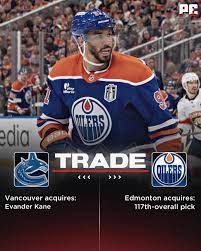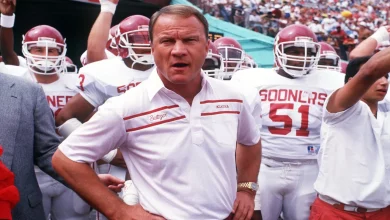The Oilers traded forward Evander Kane to the Canucks and received a 2025 fourth-round draft pick in return.

The Oilers traded forward Evander Kane to the Canucks and received a 2025 fourth-round draft pick in return.
The NHL trade market is a complex arena where teams evaluate player value, roster needs, cap implications, and future assets. The recent transaction where the Edmonton Oilers traded forward Evander Kane to the Vancouver Canucks in exchange for a 2025 fourth-round draft pick exemplifies these strategic considerations. While on the surface it appears as a straightforward asset exchange, a deeper examination reveals multiple layers of team strategy, player evaluation, and league dynamics.
This analysis aims to unpack the rationale behind the trade, its potential impact, and what it signifies within the broader context of NHL team management.
Background: The Players and Teams Involved
Evander Kane: The Player Profile
Evander Kane, born in 1991, is a talented but often controversial NHL forward known for his scoring ability, physicality, and skating. Throughout his career, Kane has been recognized for his offensive production as well as his aggressive style of play. However, his career has also been marked by off-ice issues, disciplinary concerns, and fluctuating performance levels.
Kane’s career began with the Atlanta Thrashers (later Winnipeg Jets), where he established himself as a promising scorer. He subsequently played for the San Jose Sharks, where he was a key offensive contributor but also faced scrutiny over his conduct and injury history. Joining the Edmonton Oilers in 2022, Kane was viewed as an important piece for their offensive depth and playoff push, bringing experience and scoring talent to the team.
The Edmonton Oilers: Context and Rationale
The Oilers, led by star Connor McDavid and other offensive talents, have been invested in building a competitive roster capable of contending for the Stanley Cup. Kane’s addition was part of a broader strategy to strengthen their forward lines, especially for playoff runs.
However, the Oilers also face salary cap constraints, roster flexibility issues, and the need to balance veteran leadership with developing younger players. The decision to trade Kane may have been driven by several factors: performance concerns, cap management, off-ice issues, or a shift in team direction.
The Vancouver Canucks: Strategic Needs and Asset Management
The Canucks, a team often focused on rebuilding or retooling, are in a different phase of their franchise cycle. Acquiring Kane suggests they are seeking experienced forwards who can contribute immediately or serve as assets in their ongoing development.
The 2025 fourth-round pick signifies a relatively low-cost investment, reflecting the Canucks’ valuation of Kane as a role player or an asset to be flipped or developed.
The Trade Details: What Was Exchanged?
The trade involved the Edmonton Oilers sending Evander Kane to the Vancouver Canucks in exchange for a 2025 fourth-round draft pick. Notably, this is a future draft asset, emphasizing that the exchange is more about team-building strategy than immediate roster needs.
The specifics indicate:
- For the Oilers: Gaining a future asset rather than immediate roster space or cap relief.
- For the Canucks: Acquiring an established NHL forward with offensive experience, albeit with some risks associated with Kane’s history.
This type of trade underscores the NHL’s trend toward asset management—teams trading future picks to balance their roster, cap, and strategic goals.
Strategic Considerations Behind the Trade
Edmonton Oilers’ Perspective
- Cap Management and Roster Flexibility
The Oilers may have been facing salary cap pressures or roster constraints. Trading Kane for a future draft pick allows them to free up cap space or open roster spots without immediately losing a player they valued.
- Performance and Fit
Kane’s performance with the Oilers might not have met expectations, or the team could have identified other needs—such as defensive depth, young prospects, or a different forward profile—that made Kane expendable.
- Off-Ice Considerations
Kane’s off-ice issues, including disciplinary concerns or personal matters, might have influenced management’s decision. Moving him could be a way to mitigate risk or shift focus toward team cohesion.
- Future Planning
Acquiring a 2025 draft pick indicates a focus on long-term strategy, perhaps preparing for a rebuild or retooling phase, or accumulating assets for future trades.
Vancouver Canucks’ Perspective
- Adding Experienced Depth
The Canucks see value in adding a player like Kane—an experienced NHL forward who can contribute offensively and provide veteran leadership.
- Cost-Effective Asset Acquisition
Acquiring Kane for a fourth-round pick is a low-cost investment, fitting within a broader strategy of acquiring depth without significant cap commitments or draft capital.
- Potential for Development or Flipping
The Canucks might view Kane as a role player who can help immediately or as an asset they could flip later for other assets or prospects, especially if he performs well.
- Rebuilding or Reassessing
If the Canucks are in a rebuilding phase, adding a veteran with offensive experience can help stabilize the locker room and mentor younger players.
Broader Implications of the Trade
Player Valuation and Asset Management
This trade highlights how NHL teams value draft picks as future assets rather than immediate roster pieces. The choice of a fourth-round pick reflects the perception of Kane’s value—significant enough to acquire but not at the level of a high draft pick.
Roster and Cap Strategy
Trading for future picks allows teams to maintain roster flexibility, especially in a league with a tight salary cap. It also signals a willingness to reallocate resources and plan for future seasons.
Market Trends in NHL Trades
In recent years, NHL teams have increasingly prioritized drafting and asset accumulation, often trading established players for future picks, especially when facing cap constraints or roster uncertainties.
Risk and Reward
While Kane’s talent is evident, his off-ice history presents risks. Both teams must weigh these factors—whether Kane’s on-ice contributions outweigh potential disciplinary or character issues.
Potential Future Developments
For the Oilers
- Rebuilding or Reallocating Assets: The Oilers might use the 2025 draft pick to select a prospect or trade it for other assets.
- Roster Reassessment: The team could use this trade as a precursor to further roster moves, possibly seeking to acquire prospects, younger players, or additional draft capital.
For the Canucks
- Immediate Contribution: Kane may serve as a depth forward, contributing offensively or physically.
- Trade Chip: If Kane performs well, the Canucks could leverage him in future trades or negotiate extensions.
- Development Role: The team might see Kane as part of their veteran core, mentoring younger players.
Broader NHL Trade Philosophy Exemplified
This trade reflects several broader NHL trends:
- Asset-Based Management: Teams trading future draft picks for immediate needs or vice versa.
- Strategic Flexibility: Using trades to balance short-term competitiveness with long-term planning.
- Low-to-Mid Value Trades: The use of lower-round picks for seasoned players is common for teams seeking to manage cap and roster depth efficiently.
- Rebuilding vs. Contending Strategies: Teams in different phases of their competitive cycle leverage trades differently—contenders may trade prospects for veterans, while rebuilding teams might do the opposite.
A Strategic Move with Long-Term Implications
The Edmonton Oilers’ decision to trade Evander Kane to the Vancouver Canucks for a 2025 fourth-round draft pick exemplifies the strategic, multifaceted nature of NHL asset management. While the immediate impact on either team’s roster may seem modest, the underlying motivations and future implications are significant.
For the Oilers, this trade is likely part of a broader plan to optimize their roster and manage salary cap constraints, focusing on future assets. For the Canucks, acquiring Kane for a low draft pick provides immediate depth and potential upside, with the flexibility to develop or leverage him in future trades.
As NHL teams continue to balance short-term success with long-term sustainability, such trades will remain a vital part of franchise strategy, illustrating the league’s evolving approach to roster building, asset allocation, and cap management.









